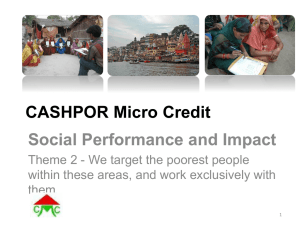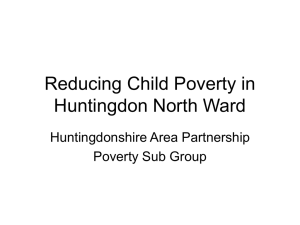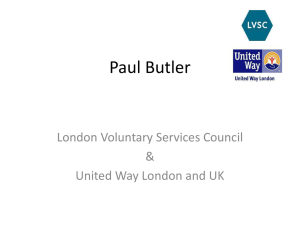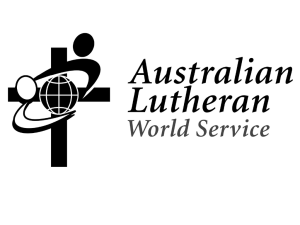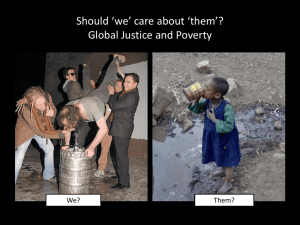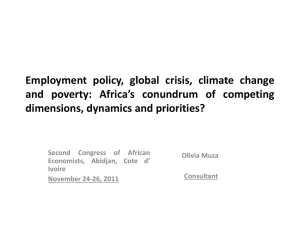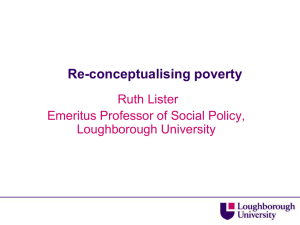RRPG5-sharifahUSM
advertisement
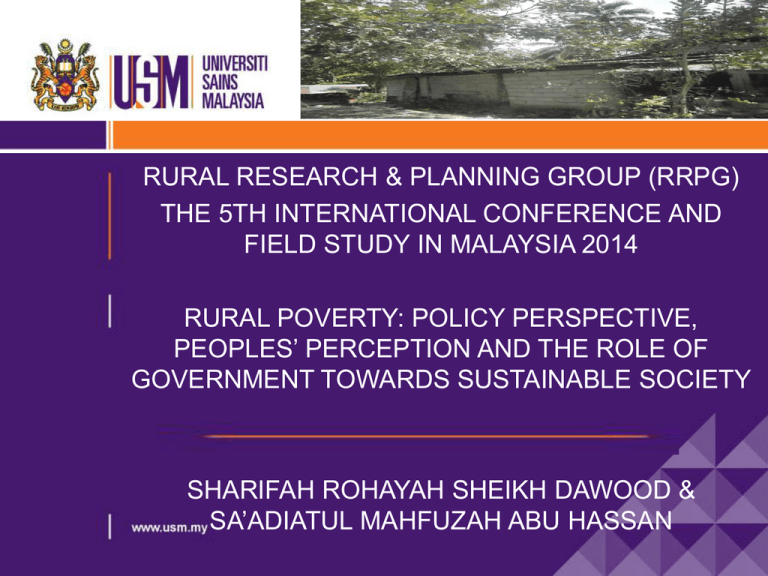
RURAL RESEARCH & PLANNING GROUP (RRPG) THE 5TH INTERNATIONAL CONFERENCE AND FIELD STUDY IN MALAYSIA 2014 RURAL POVERTY: POLICY PERSPECTIVE, PEOPLES’ PERCEPTION AND THE ROLE OF GOVERNMENT TOWARDS SUSTAINABLE SOCIETY SHARIFAH ROHAYAH SHEIKH DAWOOD & SA’ADIATUL MAHFUZAH ABU HASSAN INTRODUCTION Government effort: 1) New Economic Policy (NEP) - eradicate poverty irrespective of race - restructure the society in order to correct economic inbalances - eliminate the identification of races with economic functions 2) National Development Policy (DPN) - underdeveloped - trapped by unemployment and poverty - done through the rural restructuring of the society - Focus on development more concentrated in rural areas that needs to increase the quality of life in the rurality INTRODUCTION Main Objectives: - Explore the types of programs introduced in the rural villages and its impact to the life of the communites Three Rural Areas: 1) Parit Buntar (Kg Tanjung Tiandang, Kg Kedah, Kg Titi Serong and Kg Simpang Empat ) 2) Baling (Kg Sera Ulu, Kg Sera Baru, Kg Dalam Wang and Kg Titi Teduri) 3) Penang (Seberang Perai Utara) - Methods being used included quantitative (questionnaire survey) and qualitative (informal interview) with the rural communities - Villagers’ perceptions on the programs were deemed necessary and important to evaluate the nature of the program, its accessibility and effectiveness to the community being studied in that area LITERATUR REVIEW: POVERTY ERADICATION Malaysia: - Improving the standards of living - Expanding the trade - Capital and technology flows - Leaving notable progress in poverty reduction - Malaysia has indeed achieved the MDGs of alleviating poverty rate well before 2015, poverty had declined from 52.4% in 1970 to 12.4% in 1992 and further reduced to 3.8% in 2009 (Abdul Hakim et al. 2010; Muhamed and Haron, 2011; EPU, 2012) Elements identified in Defining Poverty: 1) Poverty can be reduced or eradicated to rescue people from social problems 2) Identify who are the poor and their social group 3) Determine poverty in general for certain community groups LITERATUR REVIEW: POVERTY ERADICATION Poor people included: - Old people alone - People with less education living in suburban or rural areas - Immigrants - Long term unemployed - Single mothers - Children living 1 poor households - Prisoners and ex-prisoners - Alcohol and drug abusers According to U. Aziz (1964): - Poverty is not getting the enough income to fulfill the basic needs - Nutrition deficit/Malnutrition LITERATUR REVIEW: POVERTY ERADICATION Poverty is divided into four types: 1) Relative 2) Absolute 3) Structural 4) Normative (See Holman, 1978) C. Siwar (2001): 1) Economic dimension (lack of basic amenities in terms of income, financial needs or capital) 2) Socio-cultural dimension (poverty culture) 3) Education dimension (mentality and knowledge) 4) Health dimension (malnutrition, hunger, physical and mental disability) LITERATUR REVIEW: POVERTY ERADICATION 5) Spatial dimension (rural or urban area) 6) Gender dimension (women and single mothers) 7) Environmental dimension (deteriorating ecology, degradation and pollution - Rural areas: household is categorized as hardcore poor if their income level below RM666/per month - Urban areas: household with a monthly income of RM2, 000 and accumulated asset of less than RM50, 000 is categorized as urban poor and eligible for the Micro Credit Fund of Amanah Ikhtiar Malaysia (AIM) (Awang Selamat, 2009). LITERATUR REVIEW: POVERTY ERADICATION Table 1 shows the Base Line Poverty Level (PGK) set up by EPU for rural and urban area of Peninsular Malaysia, Sabah and Sarawak Table 1: Base Line Poverty Level (PGK) REGION SEMENANJUNG Malaysia Urban Rural Sabah & Labuan Urban Rural Sarawak Urban Rural POOR PGK 2012 HOUSEHOLD PER CAPITA 830 210 840 790 1, 090 1, 080 1, 120 920 960 870 220 190 240 240 240 230 230 220 HARDCORE POOR PGK 2012 HOUSEHOLD PERCAPITA 520 130 510 530 660 630 710 600 630 570 130 120 140 140 150 140 150 140 Source: Economic Planning Unit; Office of Federal Development, Kedah, 2013 LITERATUR REVIEW: POVERTY ERADICATION - Reference to the EPU data, the PGK for 2009 is standardized in the 10th Malaysia Plan (RMK-10) which is poor PGK RM760 for the household - Meanwhile hardcore poor is RM460 (Ministry of Women, Family and Community Development, 2012) - The PGK set up by the Ministry in 2012 is in tandem with the states throughout Malaysia except for Penang whereby between the year 2009-2011, the hardcore poor is RM500 and below, in 2012 is RM600 and below and for 2013 is RM770 and below - Meanwhile the PGK for poor in Penang is RM770 and above (Implementation Coordination Unit, Penang, 2013). POVERTY IN THE NORTHERN STATES OF MALAYSIA - The analysis revolves around the incidence of poverty in the district of Kedah and Perak - A pilot study was undertaken in two separate villages in Perak and Kedah respectively - Further survey is done to gather data and information regarding district with the highest poverty level in order to examine the spatial inequalities between regions - This is followed by a discussion about the programs provided to the rural communities to eradicate poverty POVERTY IN THE NORTHERN STATES OF MALAYSIA Table 2 shows the statistic for poverty in the districts of Kedah for the year 2011 Table 2: Statistic of Poverty for Kedah Districts, 2011 Bil 1. 2. 3. 4. 5. 6. 7. 8. 9. 10. 11. 12. District Baling Bandar Baharu Kota Setar Kuala Muda Kubang Pasu Kulim Padang Terap Pendang Pokok Sena Pulau Langkawi Sik Yan Total Poor 1, 572 86 634 607 389 348 258 264 519 109 941 349 6, 073 Poverty Level Hardcore Poor 2, 113 170 2, 067 1, 473 877 629 574 719 662 172 2, 050 819 12, 322 Total 3, 685 256 2, 701 2, 080 1, 263 974 832 983 1, 181 281 2, 991 1, 168 18, 395 Source: Economic Planning Unit, Kedah, 2011 POVERTY IN THE NORTHERN STATES OF MALAYSIA - The figures shows that the highest statistic for poverty level is for the district of Baling with 1, 572 people and hardcore poor is 2, 113 people as compared to other districts Meanwhile Table 3 shows the statistic of poverty for 2013 State/District/Mukim Kedah Total Baling Bandar Baharu Kota Setar Kuala Muda Kubang Pasu Kulim Langkawi Padang Terap Pendang Pokok Sena Sik Yan Poor 2013 Quarter year (Forth) December Poverty Level Hardcore Easily Poor Marginalized Total No of Household Head (NoH) NoH NoH NoH NoH 903 128 817 1026 784 324 179 478 281 149 879 386 6334 6334 217 29 214 223 151 73 34 108 84 43 245 71 1492 1492 647 242 724 1409 805 387 354 503 300 190 891 477 6929 6929 1206 254 907 1396 933 493 423 742 439 218 1159 416 8586 8586 2973 653 2662 4054 2673 1277 990 1831 1104 600 3174 1350 23341 23341 POVERTY IN THE NORTHERN STATES OF MALAYSIA The following tables show statistic of poverty for Penang in 2011 and 2013 respectively Table 4: Statistic of Poverty by District in Penang, 2011 District Jan 343 201 63 38 125 770 202, 435 SPU SPT SPS DTL DBD Total Assist Total (RM) Feb 342 187 64 38 128 759 199, 165 Mac 342 185 64 38 127 756 198, 365 April 323 187 65 40 126 741 192, 670 Mei 323 186 66 41 126 742 192, 670 Hardcore Poor Jun July 323 323 188 186 66 66 41 42 125 125 743 742 188, 188, 620 135 Aug 323 186 66 43 125 743 188, 465 Sept 272 185 66 43 124 690 175, 685 Okt 272 186 66 43 124 691 176, 925 Nov 272 188 66 44 126 696 176, 925 Dis 295 187 66 47 126 721 182, 515 Sumber: Unit Perancang Ekonomi Penang, 2013 Table 5: Statistic of Poverty by District in Penang, 2013 District SPU SPT SPS DTL DBD Total Assist Total (RM) Jan 396 185 60 68 116 825 211, 325 Feb 396 185 60 68 116 825 211, 025 Mac 397 181 60 55 114 807 203, 930 April 387 181 55 55 110 788 198, 170 Mei 387 181 55 57 110 790 198, 150 Poor Jun July 416 426 180 179 55 64 57 57 111 111 819 837 209, 219, 911 591 Aug 426 179 69 60 111 845 222, 305 Sept 434 178 69 65 114 860 227, 570 Okt 441 189 69 67 114 880 231, 250 Nov - Dis - Sumber: Unit Perancang Ekonomi Penang, 2013 POVERTY ERADICATION PROGRAMS Economic Policies in Nigeria: Programs like: 1) Universal Free Primary Education (UPE) 2) Subsidy program for various activities especially agriculture, credit facilities and social services, health services, rural water supply scheme, rural electricity supply by the Rural Electrification Board (REBs) 3) Directory for Food, Roads and Rural Infrastructure (DFRRI): infrastructural development, focusing on women in the rural villages like for food processing activities, starting new business to improve life style, health and collaboration POVERTY ERADICATION PROGRAMS 4) Rural community banking, National Directorate of Employment (NDE), Small and Medium Enterprises and family support programs (Oyeranti et al., 2005) 5) Programs provided by government (multi-sectoral program for agriculture, health, education and transportation) 6) The National Directorate of Employment (multi-sectoral program that provides skill enhancement and public work program) 7) Agricultural programs involve the National Agricultural Land Development Authority, the Strategic Grains Reserves Program and the Program for Accelerated Wheat Production POVERTY ERADICATION PROGRAMS 8) Health sector, programs such as Primary Health Care (PHC) Scheme and Guinea-worm Eradication Program were introduced 9) Programs for education includes Nomadic Education Program to establish education curriculum, training for teachers and infrastructure facilities for school 10) Transportation sector involves the Federal Urban Mass Transit Program providing new public bus services POVERTY ERADICATION PROGRAMS International Fund for Agricultural Development (IFAD): - international financial institution established in 1977 to eradicate poverty and enhance food production - specialized mission is to enable poor rural people to overcome poverty by mobilizing resources to invest in development opportunities for poor rural people, including helping to improve the lives of the communities by building farm and non-farm enterprises that are sustainable and integrated into national and global markets and value chains - aims to empower poor rural women and men in developing countries to achieve higher incomes and improved food security PROGRAM FOR SUSTAINABLE RURAL COMMUNITY IN MALAYSIA Government strategy: through the Ministry of Rural & Regional Development (KKLW): 1) Income Increment Program (PPP) 2) Training and Career Program 3) Housing Assistance Program (PBR) 4) Human Mind Development Program 5) Balanced Supplement Food Program 6) Local Community Development Program 7) Education Excellence Program 8) Child-care Center Program 9) ASDB-Sejahtera Program PROGRAM FOR SUSTAINABLE RURAL COMMUNITY National Development Plan (NDP 1991-2000): - to lessen the rate of poverty Under the Dasar Wawasan Negara 2001-2010: - aimed to reduce poverty level to 0.5% in 2005 - Direct financial assistance was limited especially for the elderly and the disabled - The program for poverty eradication is mostly concentrated in agriculture sector due to the fact that this sector constitutes the highest proportion of poor communities PROGRAM FOR SUSTAINABLE RURAL COMMUNITY - - Amongst the programs implemented were to relocate those who are without land and with small size of land that is noneconomical into the scheme for new land The pioneers were provided with a complete house with electricity and water, able to develop the land in-situ through conservation and land merging DISCUSSION - Responden detail were obtained from District office of Baling, Parit Buntar and Seberang Prai - Some other information was also gathered from the district Penghulu & Welfare Department Committee of the JKKK through the Ketua Kampung - Primary data (questionnaire survey and informal interview) - Secondary data (from state authorities) - From the survey, programs for assisting the rural community for the three states are provided by the Welfare Department (JKM): a) Assistance for single mothers b) Education c) Assistance for the disabled (OKU) - Of this, important issues are covered for two areas: Baling, Kedah and Parit Buntar, Perak DISCUSSION Table 6 illustrates the programs in Kedah, Penang and Northern Perak - Based on the survey findings, there are 122 respondents and out of this only 25 receive this aid from the government - Whereas the remaining 97 do not receive any form of aid or government assistant program - Most of the government aid program for the communities is received through the Welfare Department (JKM) such as aid for the elderly, single mothers, institution of higher education - Majority gave the feedback on the 1 Malaysia People’s Aid (BRIM). This is the outcome of the 2012 Budget Presentation: the government announced to give out a one-off cash payment RM 500 to households with an income of less than RM3, 000 a month DISCUSSION Table 6: Communities ‘Assistance Program in Kedah, Penang and Perak JENIS BANTUAN KEDAH Welfare Department and People’s Housing Welfare Department and Single Mothers PERAK I Malaysia People’s Aid (BR1M) Family, Women and Society (KWAMP) Pension Palau Pinang Institution of Higher Learning Aid Single Mother Schooling JUMLAH KEKERAPAN 1 1 10 2 1 5 4 1 25 Source: Survey, Field Study, 2014 DISCUSSION - - - - Under the JKM there are various government aid program which is among others the aid for the elderly, aid for children, for the poor and homeless, flood survivors, welfare aid and help for the disabled communities (JKM, 2013) The Table and Figure below show the number of respondents for the field survey in three districts of the state of Perak, Penang and Kedah The number of female respondents outnumbered the male respondents since those women were at home during the time of the interview were done Most of the male household was out to work at that time, thus the selection of respondents turn out to be female dominated which is about 78 of them as compared to 44 male from the age group of between 21-61 DISCUSSION - - Female respondents were mainly in the age group of 41-50 (21 of them). Whereas, the highest number of male respondents came from the age group of over 61 years old The questions asked was on the type of financial aid given, funding program, how the funding arranged and to what extent the respondents agreed that the aid/program help eradicate poverty in the rural area Table 7: Number of Respondents by Gender in Baling, Parit Buntar & Penang Gender Male Total Female <21 1 4 5 21-30 2 6 8 31-40 9 12 21 41-50 8 21 29 51-60 6 16 22 18 19 37 44 78 122 Age 61> Total DISCUSSION Table 8: Government Financial Aid for the Rural Communities Frequency Percent Valid Percent Cumulative Percent 0 3 2.5 2.5 2.5 Yes 46 37.7 37.7 40.2 No 73 59.8 59.8 100.0 122 100.0 100.0 Valid Total Table 8 reveals that only 37.7% received financial aid from the government as compared to 59.9% who do not receive any aid/assistance. This is due to the reason that most of the assistance goes to the most deprived and poor with the highest number of household. The determining factor for eligibility is based on level of income, status of the head of household, disability and number of household and number of children that is still schooling DISCUSSION Table 9: Limited Government Aid to Eradicate Poverty Frequency Percent Valid Percent Cumulative Percent Valid 0 2 1.6 1.6 1.6 Strongly Disagree 5 4.1 4.1 5.7 Disagree 20 16.4 16.4 22.1 Not Sure 11 9.0 9.0 31.1 Agree 76 62.3 62.3 93.4 8 6.6 6.6 100.0 122 100.0 100.0 Strongly Agree Total Table 9 shows the level of satisfaction amongst the respondents from the scale as stated above. About 76 respondents agree that government aid is limited in eradicating poverty whereas 20 respondents disagree with the statement. 11 respondents were not sure and only 5 strongly disagree and 8 strongly agree. The number of those that strongly disagree that the government aid is limited is very few because there are many channels whereby the communities can benefit from the aid and assistance to overcome poverty incidence. However the access to information amongst the villagers are limited. Opportunities to apply for aid/assistance whether for short or long term usually goes through the Ketua Kampong (Head of Village). In fact the villages are unaware of the channels that they should go to for applying aid, to whom that they should approach and there is no access for transportation for their mobility especially for those very elderly and ill. Their hope is the role of the Ketua Kampong to help them for getting the aid properly DISCUSSION Table 10: : Limited Financial Aid Frequency Percent Valid Percent Cumulative Percent Valid 0 3 2.5 2.5 2.5 Strongly Disagree 8 6.6 6.6 9.0 Disagree 29 23.8 23.8 32.8 Not Sure 7 5.7 5.7 38.5 Agree 64 52.5 52.5 91.0 Strongly agree 11 9.0 9.0 100.0 122 100.0 100.0 Total Table 10 reveals that there are some villagers that agree that the aid given by government especially the financial assistance is inadequate. About 64 people in the three districts agree with the statement which is 52% of them. The financial aid given is based on the number of household in a family. If the number of household is 4, the financial aid given is RM450 and if the number of household is 2, the total aid is RM200 (Telephone Interview, Welfare Department of Kerian District, 18th of July 2014) DISCUSSION Table 11: Financial Aid Able to Elevate Poverty Level Frequency Valid Percent Valid Percent Cumulative Percent 0 4 3.3 3.3 3.3 Strongly Disagree 7 5.7 5.7 9.0 Disagree 20 16.4 16.4 25.4 Not Sure 9 7.4 7.4 32.8 Agree 69 56.6 56.6 89.3 Strongly Agree 13 10.7 10.7 100.0 122 100.0 100.0 Total In terms of financial aid able to elevate poverty level, about 69 people agree with this statement. Only 20 people disagree with this. They felt that the aid provided by the government is effective to elevate poverty level among the villagers but can only help to ease their financial problem for short term. According to Encik AZ, an informant from Parit Buntar, the financial aid is not enough for his big household. And most of this aid is basically for education and higher institution financial aid which is seasonal (Informal Interview, 16th of July 2014). The table below gives more detail on this DISCUSSION Table 12: Types of Aid Received Frequency Percent Valid Percent Cumulative Percent None 77 63.1 63.1 63.1 Welfare Department 13 10.7 10.7 73.8 People’s Housing Scheme 4 3.3 3.3 77.0 Single Mother Program 4 3.3 3.3 80.3 Education Program 9 7.4 7.4 87.7 Higher Institution Program 8 6.6 6.6 94.3 Program for the Disabled 2 1.6 1.6 95.9 More than one program 5 4.1 4.1 100.0 122 100.0 100.0 Total The table shows the type of aid received by the villagers. Out of 122 people, 77 did not receive any aid from the government CONCLUSION - This research aims to explore the response of the rural communities in the northern states of the Peninsular Malaysia towards government assistance program to eradicate poverty level - There are various programs being implemented to help the rural villagers in the form of: a) financial support b) programs for education c) housing and others - The level of accessibility towards the program, the effectiveness of the program have actually helped to bring out some of the communities from poverty trap. However there are also some villagers who do not receive enough aid/assistance due to some underlying factors as discussed above. CONCLUSION - Nevertheless, many of the villagers have taken the opportunities given by the government to improve and upgrade their life - It is anticipated that in the long run, more programs can be effectively implemented and more thoroughly evaluated and monitored programs based on the eligibility and condition of the rural people need to be done from the authorities involved - The findings also revealed that the level of access to information needs to be examined and improved especially in terms of the relationship between the Kampong Head (Ketua Kampung) and the villagers. CONCLUSION - More opportunities should be given for the rural people in terms of having access to social media and how this can help educate them more on the types of programs provided by the government and how they can apply for it - There is a need for a more holistic nature in approaching this issue of poverty and how the rural people can be helped out and rescued from further difficulties - It is more of a concerted effort from the government and other bodies as well as the villagers in order to fulfill the need of the rurality and for achieving a more sustainable community in the long term Thank You
